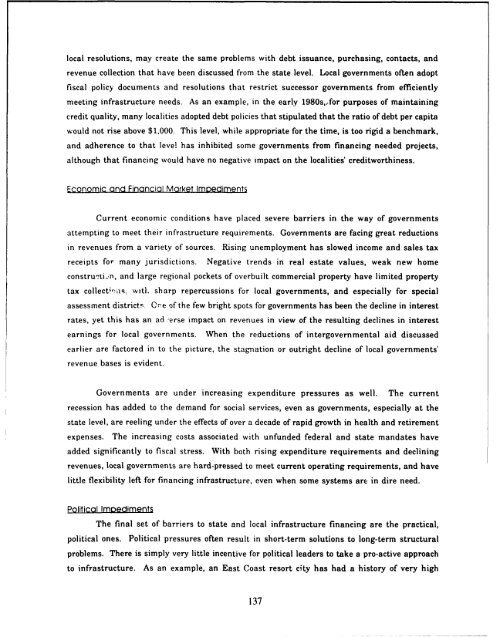Challenges and Opportunities for Innovation in the Public Works ...
Challenges and Opportunities for Innovation in the Public Works ...
Challenges and Opportunities for Innovation in the Public Works ...
Create successful ePaper yourself
Turn your PDF publications into a flip-book with our unique Google optimized e-Paper software.
local resolutions, may create <strong>the</strong> same problems with debt issuance, purchas<strong>in</strong>g, contacts, <strong>and</strong><br />
revenue collection that have been discussed from <strong>the</strong> state level. Local governments often adopt<br />
fiscal policy documents <strong>and</strong> resolutions that restrict successor governments from efficiently<br />
meet<strong>in</strong>g <strong>in</strong>frastructure needs. As an example, <strong>in</strong> <strong>the</strong> early 1980s,..<strong>for</strong> purposes of ma<strong>in</strong>ta<strong>in</strong><strong>in</strong>g<br />
credit quality, many localities adopted debt policies that stipulated that <strong>the</strong> ratio of debt per capita<br />
would not rise above $1,000. This level, while appropriate <strong>for</strong> <strong>the</strong> time, is too rigid a benchmark,<br />
<strong>and</strong> adherence to that level has <strong>in</strong>hibited some governments from f<strong>in</strong>anc<strong>in</strong>g needed projects,<br />
although that f<strong>in</strong>anc<strong>in</strong>g would have no negative impact on <strong>the</strong> localities' creditworth<strong>in</strong>ess.<br />
Economic <strong>and</strong> F<strong>in</strong>ancial Market ImDediments<br />
Current economic conditions have placed severe barriers <strong>in</strong> <strong>the</strong> way of governments<br />
attempt<strong>in</strong>g to meet <strong>the</strong>ir <strong>in</strong>frastructure requirements. Governments are fac<strong>in</strong>g great reductions<br />
<strong>in</strong> revenues from a variety of sources. Ris<strong>in</strong>g unemployment has slowed <strong>in</strong>come <strong>and</strong> sales tax<br />
receipts <strong>for</strong> many jurisdictions. Negative trends <strong>in</strong> real estate values, weak new home<br />
constru'ýtln, <strong>and</strong> large regional pockets of overbuilt commercial property have limited property<br />
tax collect,-, witi, sharp repercussions <strong>for</strong> local governments, <strong>and</strong> especially <strong>for</strong> special<br />
assessment districts.C. Oe of <strong>the</strong> few bright spots <strong>for</strong> governments has been <strong>the</strong> decl<strong>in</strong>e <strong>in</strong> <strong>in</strong>terest<br />
rates, yet this has an ad 'erse impact on revenues <strong>in</strong> view of <strong>the</strong> result<strong>in</strong>g decl<strong>in</strong>es <strong>in</strong> <strong>in</strong>terest<br />
earn<strong>in</strong>gs <strong>for</strong> local governments. When <strong>the</strong> reductions of <strong>in</strong>tergovernmental aid discussed<br />
earlier are factored <strong>in</strong> to <strong>the</strong> picture, <strong>the</strong> stagnation or outright decl<strong>in</strong>e of local governments'<br />
revenue bases is evident.<br />
Governments are under <strong>in</strong>creas<strong>in</strong>g expenditure pressures as well. The current<br />
recession has added to <strong>the</strong> dem<strong>and</strong> <strong>for</strong> social services, even as governments, especially at <strong>the</strong><br />
state level, are reel<strong>in</strong>g under <strong>the</strong> effects of over a decade of rapid growth <strong>in</strong> health <strong>and</strong> retirement<br />
expenses. The <strong>in</strong>creas<strong>in</strong>g costs associated with unfunded federal <strong>and</strong> state m<strong>and</strong>ates have<br />
added significantly to fiscal stress. With both ris<strong>in</strong>g expenditure requirements <strong>and</strong> decl<strong>in</strong><strong>in</strong>g<br />
revenues, local governments are hard-pressed to meet current operat<strong>in</strong>g requirements, <strong>and</strong> have<br />
little flexibility left <strong>for</strong> f<strong>in</strong>anc<strong>in</strong>g <strong>in</strong>frastructure, even when some systems are <strong>in</strong> dire need.<br />
Political Impediments<br />
The f<strong>in</strong>al set of barriers to state <strong>and</strong> local <strong>in</strong>frastructure f<strong>in</strong>anc<strong>in</strong>g are <strong>the</strong> practical,<br />
political ones. Political pressures often result <strong>in</strong> short-term solutions to long-term structural<br />
problems. There is simply very little <strong>in</strong>centive <strong>for</strong> political leaders to take a pro-active approach<br />
to <strong>in</strong>frastructure. As an example, an East Coast resort city has had a history of very high<br />
137







